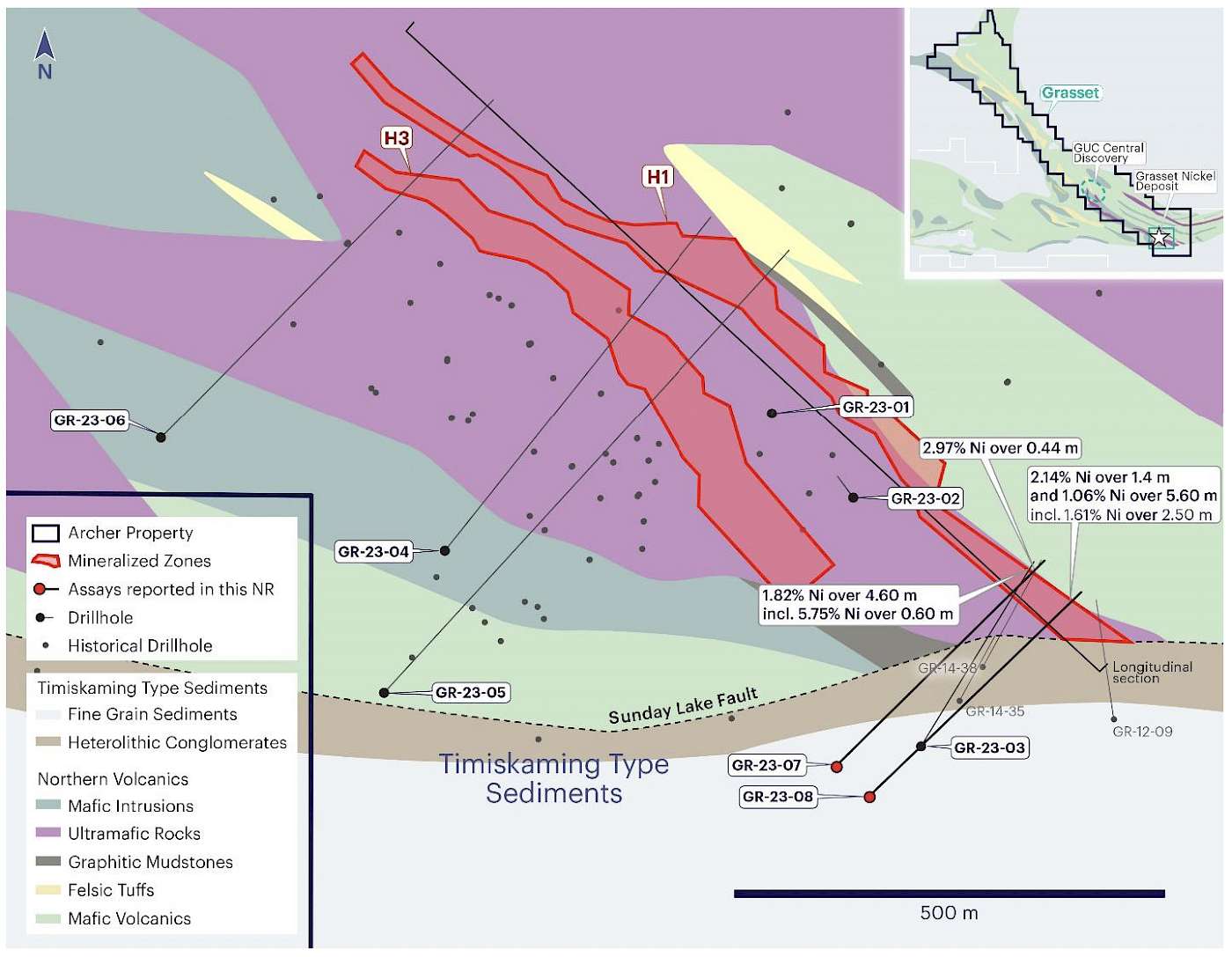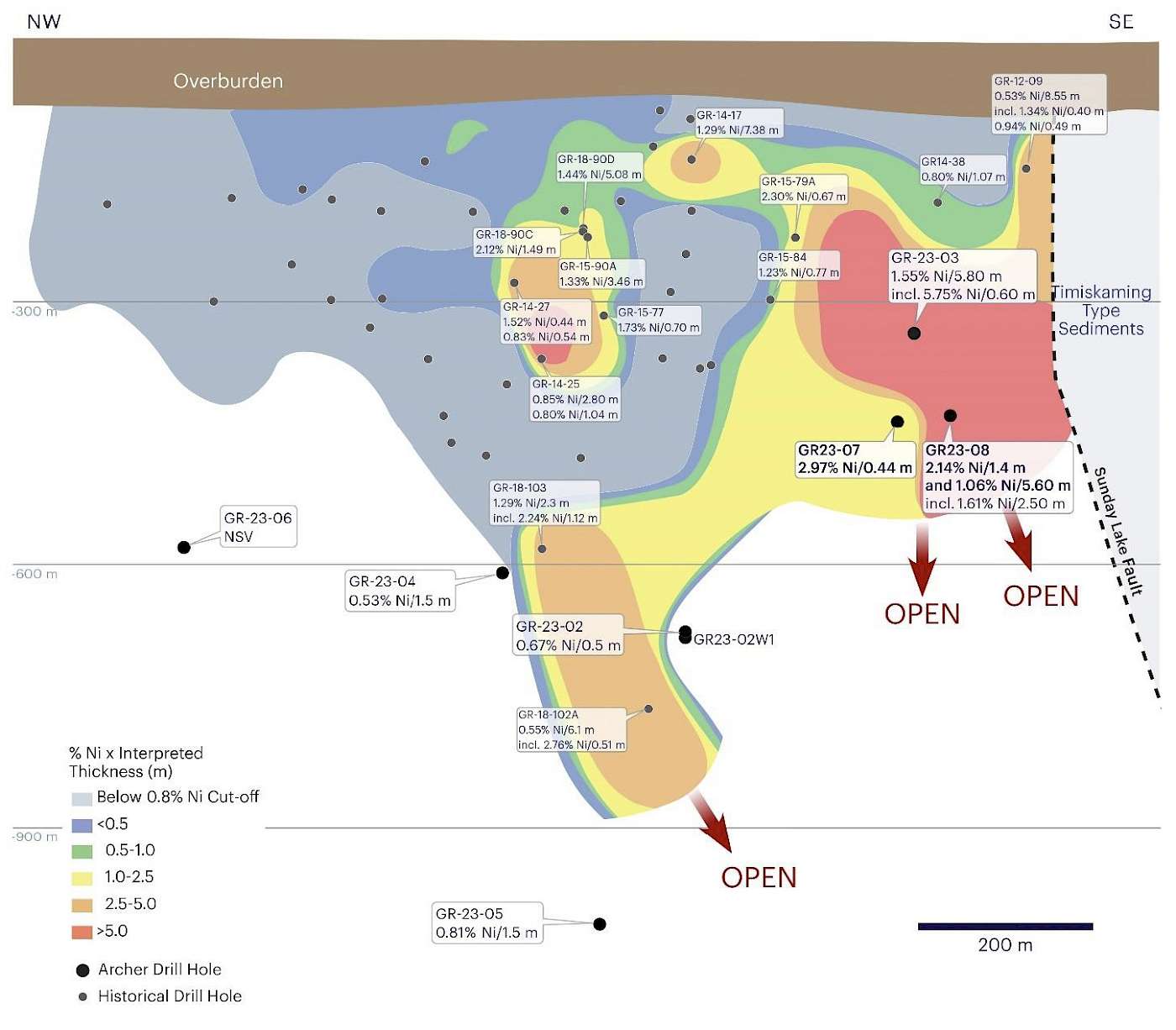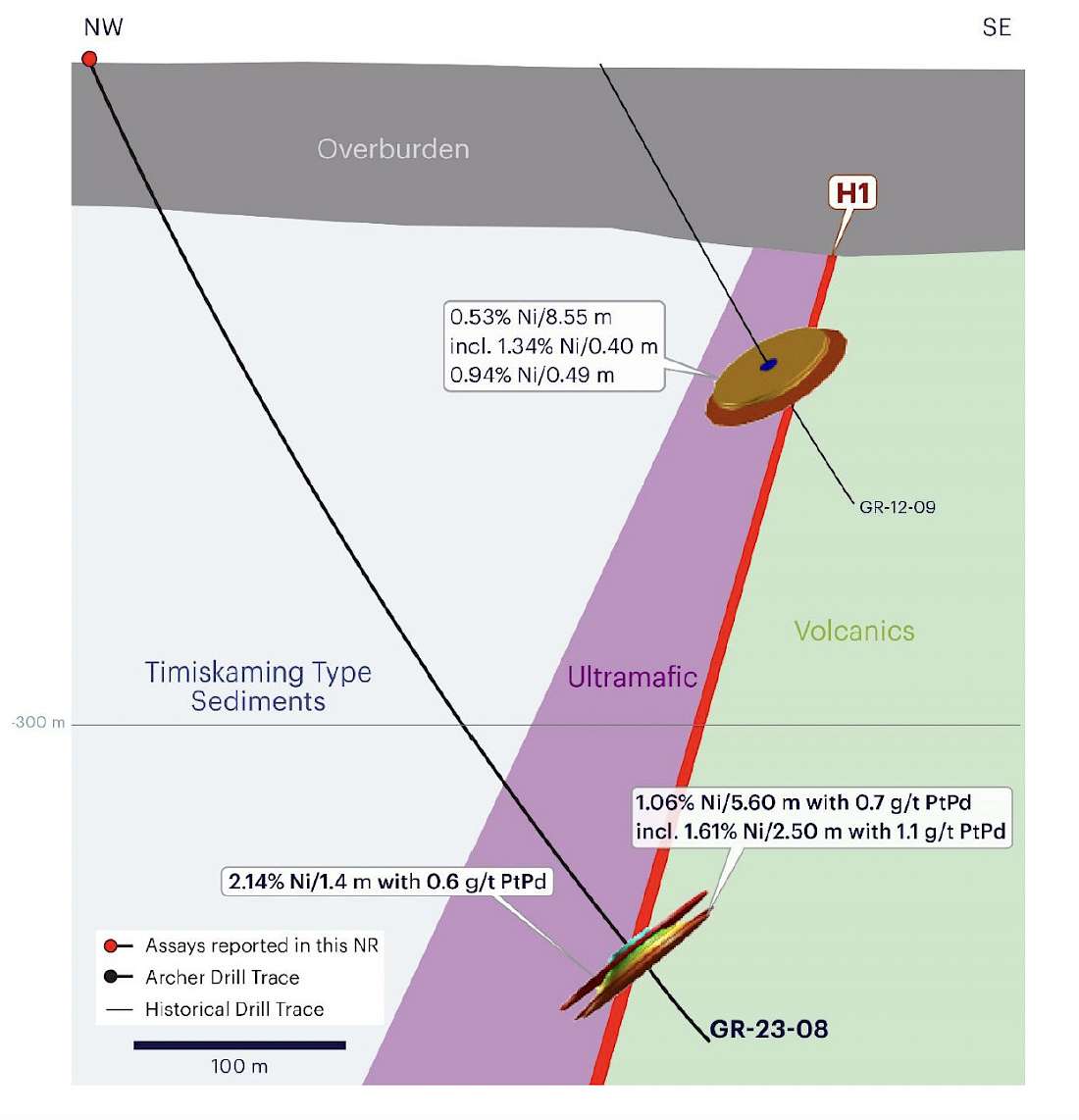News
Archer Exploration Extends Mineralization to Depth in H1 Discovery Zone of Grasset Nickel Project
VANCOUVER, BC, January 17, 2024 – Archer Exploration Corp. (CSE: RCHR) (OTCQB: RCHRF) (FSE: 6YR0) (the “Company” or “Archer”) is pleased to announce the results of its 2023 Fall drilling program at its 100% owned Grasset Nickel Project (“Grasset”) in the Abitibi Greenstone Belt of Quebec, Canada.
Highlights
- Two holes drilled in December 2023 extend the H1 Discovery Zone by a depth of approximately 100 metres
- Hole GR23-07 intersected 0.44 metres of massive sulphides grading 2.97% Ni, 0.1% Cu, 4.1 g/t Pt-Pd under GR23-03 at a depth of 430 metres
- 60 metres to the South-East, at a depth of 420 metres, GR23-08 intersected:
- 2.14% Ni, 0.91% Cu, 0.6 g/t Pt-Pd over 1.40 metres of net texture sulphides
- 1.06% Ni, 0.14% Cu, 0.7 g/t Pt-Pd over 5.60 metres, including 1.61% Ni, 0.24% Cu, 1.1 g/t Pt-Pd over 2.50 metres, within a zone of net texture sulphides, 3 metres below the higher grade intercept
- In July 2023, GR23-03 intersected 1.55% Ni, 0.18% Cu, 1.17 g/t Pt-Pd over 5.80 metres, including 5.75% Ni, 0.24% Cu, 5.53 g/t Pt-Pd over 0.60 metres of massive sulphides, at a depth of 330 metres
- The Company remains fully funded following a $2 million private placement in November 2023 and is planning to resume drilling at the end of January.
“Drilling the South-East extension of the H1 mineralized zone at depth continues to provide very interesting results, with nickel grades higher than the H1 Indicated Resource grade of 0.82%” commented Jacquelin Gauthier, Archer’s VP of Exploration. “With limited drilling we have discovered what looks like the fringe of another high-grade nickel conduit within a 500-metre-long untested area starting 300 metres below surface. We have great expectations for the next drilling phase that will commence in the 4th week of January”.
Fall 2023 Drill Program
The objective of the Fall drilling program was to explore the nickel-rich sulphide zone discovered during Summer 2023 drilling in the southeastern portion of the H1 mineralized Horizon and was successful in extending the high-grade H1 Discovery Zone to a known depth of approximately 430 metres. The drilling program consisted of two holes totaling 1,132 metres. Hole GR23-07 intersected the H1 zone at a depth of 430 metres, 100 metres below the high-grade intercept of hole GR23-03 (Figures 2 and 3). The northern contact of the ultramafics, where H1 mineralization is located, was strongly sheared and hosted a few metres of disseminated sulphides. Within 10 metres of the ultramafic contact the hole intersected 0.44 metres of massive sulphides grading 2.97% Ni and 4.1 g/t Pt-Pd within felsic volcanics. Finding the massive sulphides outside the ultramafic rocks is a first on the Grasset Property but it’s not uncommon in other nickel mining camps like Sudbury, or particularly Norilsk where the bulk of the mineralization is within the sediments under the ultramafics.
Hole GR23-08 cut the H1 horizon 60 metres south-east of hole GR23-07, at a depth of 420 metres. It intersected two zones of mainly net texture sulphides that graded 2.14% Ni over 1.40 metres and 1.06% Ni over 5.60 metres respectively (Figures 2 and 4).
The results of the last two holes of 2023 confirmed the extension of the H1 mineralization at depth under discovery hole GR23-03, with nickel grades higher than the Indicated Resource grade of the H1 horizon of 0.82%. It also demonstrates the presence of a strong mineralizing system that is still open in all directions below 250 metres in the South-East part of the H1 horizon (Figure 2). Grades and textures observed indicated the potential for the last intersections to be at the fringe of a new high-grade-hosting ultramafic conduit.
Table 1: Assay Highlights of the 2023 Fall Drilling Program
|
Hole ID |
From |
To |
Length |
Ni |
Cu |
Co |
Pt |
Pd |
|---|---|---|---|---|---|---|---|---|
|
GR23-07 |
516.17 |
516.61 |
0.44 |
2.97 |
0.10 |
0.07 |
1.14 |
2.96 |
|
GR23-08 |
486.0 |
487.4 |
1.40 |
2.14 |
0.09 |
0.03 |
0.40 |
0.22 |
|
GR23-08 |
490.5 |
496.1 |
5.60 |
1.06 |
0.14 |
0.03 |
0.23 |
0.51 |
|
Including |
493.6 |
496.1 |
2.50 |
1.61 |
0.24 |
0.05 |
0.34 |
0.75 |
Figure 1 is a plan view of the southeastern portion of the Grasset property showing the location of the eight holes drilled in 2023 over a simplified geological interpretation.
Figure 2 shows the location of hole GR23-03 on a longitudinal section view with nickel metal factor values (% nickel multiplied by estimated thickness) of the H1 Horizon, including holes GR23-04, GR23-05 and GR23-06 that yielded low or non-significant nickel assays.
Figures 3 and 4, are vertical sections over holes GR23-07 and GR23-08 respectively, showing the localization of the main mineralized intersections and the general attitude of the main lithologies.
Figure 1: Grasset Geological Surface Plan
Figure 2: H1 Horizon Metal Factor Vertical Longitudinal Section
Figure 3: Hole GR23-07 Vertical Section
Figure 4: Hole GR23-08 Vertical Section
2023 Diamond Drill Hole Data
Table 2: Drillhole Collar Coordinates
|
Hole ID |
Easting |
Northing |
Elevation |
Azimuth |
Dip |
Hole Length |
|---|---|---|---|---|---|---|
|
GR23-01 |
679759 |
5539876 |
291 |
21 |
-90 |
446 |
|
GR23-02 |
679859 |
5539783 |
291 |
322 |
-88 |
759 |
|
GR23-02W1 |
679859 |
5539783 |
291 |
322 |
-88 |
874 |
|
GR23-03 |
679939 |
5539491 |
291 |
30 |
-60 |
576 |
|
GR23-04 |
679374 |
5537683 |
291 |
45 |
-55 |
885 |
|
GR23-05 |
679323 |
5539538 |
291 |
50 |
-70 |
1,152 |
|
GR23-06 |
679020 |
5539776 |
291 |
45 |
-62 |
1,104 |
|
GR23-07 |
679850 |
5539470 |
289 |
39 |
-62 |
567 |
|
GR23-08 |
679890 |
5539444 |
289 |
45 |
-65 |
565 |
Collar coordinates are UTM Zone 17N
Azimuths and dips are taken from survey record at collar unless otherwise noted
Table 3: Summary of Significant Assay Results – Ni-Cu-Co-PGE
|
Hole ID |
From |
To |
Length |
Ni |
Cu |
Co |
Pt |
Pd |
|---|---|---|---|---|---|---|---|---|
|
GR23-01 |
No significant mineralization observed |
|||||||
|
GR23-02 |
514.5 |
515.0 |
0.5 |
0.67 |
0.03 |
0.02 |
0.17 |
0.39 |
|
GR23-03 |
358.0 |
358.5 |
0.5 |
0.53 |
0.04 |
0.01 |
0.08 |
0.17 |
|
GR23-03 |
403.0 |
408.8 |
5.8 |
1.55 |
0.18 |
0.04 |
0.35 |
0.82 |
|
Including |
404.2 |
408.8 |
4.6 |
1.82 |
0.22 |
0.04 |
0.40 |
0.95 |
|
Including |
408.2 |
408.8 |
0.6 |
5.75 |
0.24 |
0.13 |
1.68 |
3.85 |
|
GR23-04 |
640.5 |
641.5 |
1.0 |
0.60 |
0.11 |
0.02 |
0.28 |
0.55 |
|
GR23-04 |
763.5 |
765.0 |
1.5 |
0.53 |
0.05 |
0.01 |
0.12 |
0.28 |
|
GR23-05 |
1012.0 |
1013.5 |
1.5 |
0.81 |
0.14 |
0.02 |
0.40 |
0.87 |
|
GR23-06 |
No significant mineralization observed |
|||||||
|
GR23-07 |
516.2 |
516.6 |
0.4 |
2.97 |
0.10 |
0.07 |
1.14 |
2.96 |
|
GR23-08 |
486.0 |
487.4 |
1.4 |
2.14 |
0.09 |
0.03 |
0.40 |
0.22 |
|
GR23-08 |
490.5 |
496.1 |
5.6 |
1.06 |
0.14 |
0.03 |
0.23 |
0.51 |
|
Including |
493.6 |
496.1 |
2.5 |
1.61 |
0.24 |
0.05 |
0.34 |
0.75 |
All lengths are downhole lengths and true widths are expected to be greater than or equal to 50-70% of downhole lengths.
Table 4: Summary of Significant Assay Results – Gold
|
Hole ID |
From |
To |
Length |
Au |
|---|---|---|---|---|
|
GR23-03 |
98.0 |
98.5 |
0.50 |
1.39 |
|
GR23-03 |
110.0 |
111.0 |
1.00 |
0.90 |
|
Including |
110.0 |
110.5 |
0.50 |
1.28 |
|
GR23-03 |
265.8 |
266.6 |
0.80 |
16.19 |
|
Including |
265.8 |
266.1 |
0.30 |
49.10 |
All lengths are downhole lengths and true widths are expected to be greater than or equal to 50-70% of downhole lengths
The Grasset Project
The Grasset Deposit, discovered in 2012 and located at the southern end of the Grasset Ultramafic Complex, comprises two subparallel, and sub-vertically dipping zones (H1 and H3 horizons) of disseminated to locally semi-massive sulphides mineralization. The H1 and H3 horizons each remain open at depth and along strike to the northwest.
In 2021, an updated mineral resource estimate, using a 2016 drilling cutoff, was completed with an Indicated Mineral Resource Estimate of 5.5 Mt grading 1.53% nickel equivalent (“NiEq”) and an Inferred Mineral Resource Estimate of 217,000 tonnes grading 1.01% NiEq. For additional information regarding Archer’s Grasset Project please refer to the Technical Report entitled “NI 43-101 Technical Report for the Grasset Property, Quebec, Canada” dated effective September 2, 2022, prepared by Carl Pelletier, P.Geo., available under Archer’s profile on www.sedarplus.ca.
The vast majority of the Grasset Ultramafic Complex is underexplored and limited exploration prior to 2016 resulted in the discovery of several significant nickel sulphides showings along the entire 23-kilometre-long belt. Most notable is the GUC Central discovery, 7 kilometres northwest of the Grasset Deposit, which hosts a 950-metre-thick ultramafic sequence with several mineralized horizons of nickel sulphides and a best mineralized intercept of 4.14% Ni over 0.65 metres, within 7.58 metres of 1.05% Ni.
The Grasset Deposit is one of the largest nickel sulphides deposits in Canada’s Abitibi region and the only North American nickel sulphides deposit, with an Indicated Mineral Resource Estimate of more than 50,000 contained tonnes of nickel and an average NiEq grade of over 1.5%, not controlled by a major mining company.
Quality Assurance and Quality Control
Archer implements high-quality industry-standard quality assurance and quality control (“QA/QC”) procedures for its diamond drill programs. Archer’s geologists insert alternating blanks and standards approximately one per every 10 samples collected. Moreover, a blank is added after logged, potentially high-grade mineralized zones with standards additionally inserted within such mineralized zones. Overall, blanks and standards account for approximately 12% of the samples submitted to the lab.
All samples are being assayed at ALS‘s Val d’Or laboratory where duplicates are inserted in the sample sequence at a rate of 1 in 40 samples sequence alternating with standards and blanks to result in a QA/QC insertion rate of about 1 in 10 samples. All drill core samples are analyzed using a 4-Acid digestion followed by 33 element ICP-AES analyses (ALS’s Code ME-ICP61). Over limit Ni results are further analyzed by 4-Acid ore grade elements ICP-AES process (Code ICP-81 or ME-OG62). Analyses for Au, Pd and Pt are done using the ore grade ICP-AES procedure (Code PGM-ICP23). Gold only assays are performed with Au-ICP21 or AU-GRA21 if any visible gold. ALS is an accredited laboratory (SCC - CAN-P-1579 and CAN-P-4E ISO/IEC 17025) and is independent of the Company.
Qualified Person
The scientific and technical content of this press release has been reviewed and approved by Mr. Jacquelin Gauthier, P.Geo, Vice President, Exploration, who is a "Qualified Person" as defined by National Instrument 43-101 - Standards of Disclosure for Mineral Projects. Mr. Gauthier is satisfied that the analytical and testing procedures used are standard industry operating procedures and methodologies, including sampling, analytical and test data underlying the technical information disclosed in this news release.
About Archer
Archer Exploration is a Canadian Ni-Cu-Co-PGE focused exploration and development company with an extensive portfolio of assets in Quebec and Ontario, Canada. The Company’s flagship asset is the Grasset Project, located within the Abitibi Greenstone Belt, with an Indicated Resource of 5.5 Mt @ 1.53% NiEq. In addition, the Company holds a portfolio of 37 properties and over 300 km2 in the world-class mining district of Sudbury, Ontario.
The Company’s growth strategy is focused on the exploration and development of its nickel sulphide properties within its portfolio. Archer’s vision is to be a responsible nickel sulphide project developer in stable pro-mining jurisdictions. Archer is committed to socially responsible exploration and development, working safely, ethically, and with integrity. For more information, please visit www.archerexploration.com.
Tom Meyer
President & Chief Executive Officer
Tel: +1 866.899.7247 (RCHR)
Email: moc.noitarolpxerehcra@mot
Cautionary Note Regarding Forward-Looking Statements
Neither the CSE nor its Market Regulator (as that term is defined in policies of the CSE) accepts responsibility for the adequacy or accuracy of this release.
The information contained herein contains “forward-looking statements” within the meaning of applicable securities legislation. “Forward-looking information” includes, but is not limited to, statements with respect to the activities, events or developments that Archer expects or anticipates will or may occur in the future. Generally, but not always, forward-looking information and statements can be identified by the use of words such as “plans”, “expects”, “is expected”, “budget”, “scheduled”, “estimates”, “forecasts”, “intends”, “anticipates”, or “believes” or the negative connotation thereof or variations of such words and phrases or statements that certain actions, events or results “may”, “could”, “would”, “might” or “will be taken”, “occur” or “be achieved” or the negative connotation thereof. Forward-looking information and statements contained herein includes, but is not limited to, statements regarding the continued exploration, drilling and anticipated completion of the Winter 2024 campaign; and that funding from the Company’s recent private placement is sufficient for operations.
Such forward-looking information and statements are based on numerous assumptions, including among others, that the results of planned exploration activities are as anticipated, the anticipated cost of planned exploration activities, that general business and economic conditions will not change in a material adverse manner, that financing will be available if and when needed and on reasonable terms, that third party contractors, equipment and supplies and governmental and other approvals required to conduct Archer’s planned exploration activities will be available on reasonable terms and in a timely manner. Although the assumptions made by Archer in providing forward-looking information or making forward-looking statements are considered reasonable by management at the time, there can be no assurance that such assumptions will prove to be accurate.
By their nature, forward-looking statements involve known and unknown risks, uncertainties and other factors which may cause our actual results, performance or achievements, or other future events, to be materially different from any future results, performance or achievements expressed or implied by such forward-looking statements. Such factors and risks include, among others: risks associated with the conduct of the Company's mining activities; risks and uncertainties associated with certain exploration and drilling tools and/or measures; regulatory, consent or permitting delays; risks relating to reliance on the Company's management team and outside contractors; risks relating to project financing and equity issuances; risks related to the use of proceeds of the Company’s recent private placement; risks and unknowns inherent in all mining projects; laws and regulations governing the environment, health and safety; operating or technical difficulties in connection with mining or development activities; employee relations, labour unrest or unavailability; the Company's interactions with surrounding communities; the Company's ability to successfully integrate acquired assets; the speculative nature of exploration and development; stock market volatility; conflicts of interest among certain directors and officers; lack of liquidity for shareholders of the Company; litigation risk; the ongoing military conflict in Ukraine and the Middle East; general economic factors (including inflationary pressure); the price of commodities; and the factors identified under the caption "Risk Factors" in the Company’s public disclosure documents.
The forward-looking information contained in this news release represents the expectations of Archer as of the date of this news release and, accordingly, is subject to change after such date. Readers should not place undue importance on forward-looking information and should not rely upon this information as of any other date. Archer does not undertake any obligation to update these forward-looking statements in the event that management’s beliefs, estimates or opinions, or other factors, should change.




